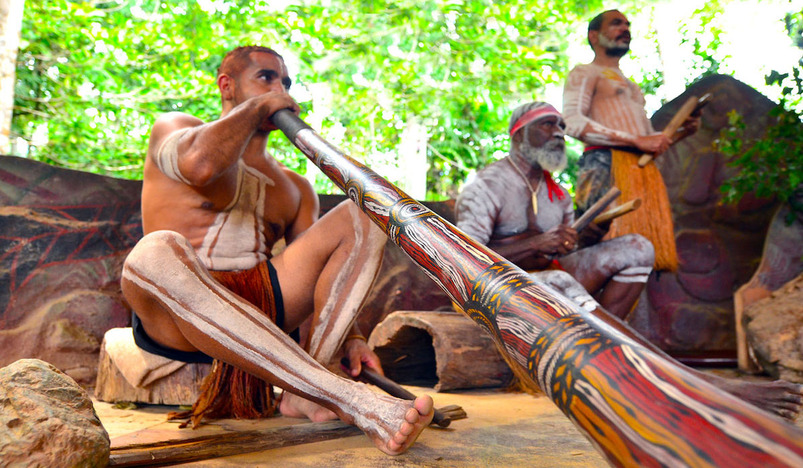
A hypnotic Swedish singing tradition
When 75,000 years ago Australia's native people left Africa, they’ve set out to form a civilization, a people, a nation which, potentially, renders the oldest continuous culture on the planet. And while they may have not intended to leave such a grandiose stamp when they’d embarked on their journey from the hot continent of Africa through the unknown territory in Asia and towards the exotic Australia (at the time, Australia and Asia were still connected by a land bridge), Aboriginal Australians have definitely made an extraordinary mark, showing exceptional survival and adaptation skills, as well as unimaginable (to the modern man) bravery in the process.
A bit on history
Aborigines and Torres Strait Islanders are two Australia’s indigenous peoples, each holding a particular cultural, historic and religious marking that’s, to this day, making Australia so fantastically special. Since the two peoples were one at a point in history, their economic and ceremonial dealings, shared cultural traits and a customary system of land-tenure law overlap, and their religion can never be talked in singular terms, as there were many.
Back in the year 1788, when the first Europeans settled in Australia – they encountered about a million Aborigines and over 200 different spoken languages. Since 1821, due to a then popular but mistaken belief that Aborigines had no religion, colonial violence started taking place with most Aboriginal communities converting to Christianity.
Many centuries before white settlement, indigenous communities had contact with the Muslim Macassan traders and Melanesians, Dutch, English and Portuguese navigators which made an impact, too.
Circa twenty years ago, in the 1996 Australian census, “more than 7000 respondents indicated that they followed a traditional Aboriginal religion”.
The tragedy
Apart from most of their land being destroyed or taken away, Aborigines faced an even greater misery and injustice. “During much of the 20th century, outright killings were replaced with a policy of removing Aboriginal children from their parents and giving them to white families or placing them in mission schools, to eradicate traces of Aboriginal culture and language”.
Nowadays, Aborigines are actively facing racist attitudes and periodic incidents of violence; their living conditions are generally poor, they have a far higher suicide rate and infant mortality rate, and a lower life expectancy than the rest of the population. Further, they make up a disproportionate section of the prison population.
A bit on religion and culture
To Aborigines, the Earth is eternal; the alive are living among the spirits of the deceased (so called “The Dreaming”) who inhabit it and they’re often associated with animals, i.e. Bowerbird-women, Kangaroo-men or Emu-men. Journeying across the Earth, they’ve left traces in the natural features of the land – animal, plant and ultimately – human life. It is these beings that have connected particular regions and languages with particular groups of people and each clan-grouping can foster contact with spirits and divinities thanks to an important religious specialist. They control everything. The way to invoke these mythic beings is through ceremonies involving song cycles accompanied by dance, sacred sites, and body painting. These ceremonies are sometimes gender segregated and they each seek a separate assistance of spiritual beings, with this assistance often depending upon humans’ continual performing of certain rituals.
Recent years have seen major indigenous festivals emerge, including Survival, Yeperenye Dreaming, Stompin’ Ground, Barunga Festival, NARLA Knock Out, Coming of the Light, CROC Eisteddfod, Laura Festival, NAIDOC and Reconciliation Week, all of which are making for fantastic tourist attractions.
Aboriginal culture in Sydney
The above passages are just tiny pieces of all that Aboriginal culture is. Just start digging, and you’ll encounter a world rich in history and culture, special and amazing in its own right.
For everyone who is looking to immerse themselves in authentic Aboriginal cultural experiences, they can do that at the First Hand Workshops and Markets at Bare Island, La Perouse. On the first Sunday of every month, the island (which is accessible by footbridge) is transformed into an Aboriginal arts festival. Immerse yourself in an authentic experience and learn how to create shell art, weave a traditional basket or make a spear. A Tribal Warrior cruise on Sydney Harbour is also great; you'll hear stories of the Cadigal, Eora, Guringai, Gammeraigal, Wangal and Wallumedegal people who were the original inhabitants of Sydney's harbour foreshore. You can find share accommodation near here and experience Aborigine culture first hand.
You can also experience Aboriginal culture by visiting one of Sydney's fine public museums. Exhibits, modern technology and films tell stories of Aboriginal culture and give you an opportunity to learn more about these amazing people.
.jpg)
Qatar Secures Place Among the World's Top 10 Wealthiest Nations
.jpg)
Hamad International Airport Witnesses Record Increase in Passenger Traffic

Saudi Arabia: Any visa holder can now perform Umrah

What are Qatar's Labour Laws on Annual Leave?
Leave a comment